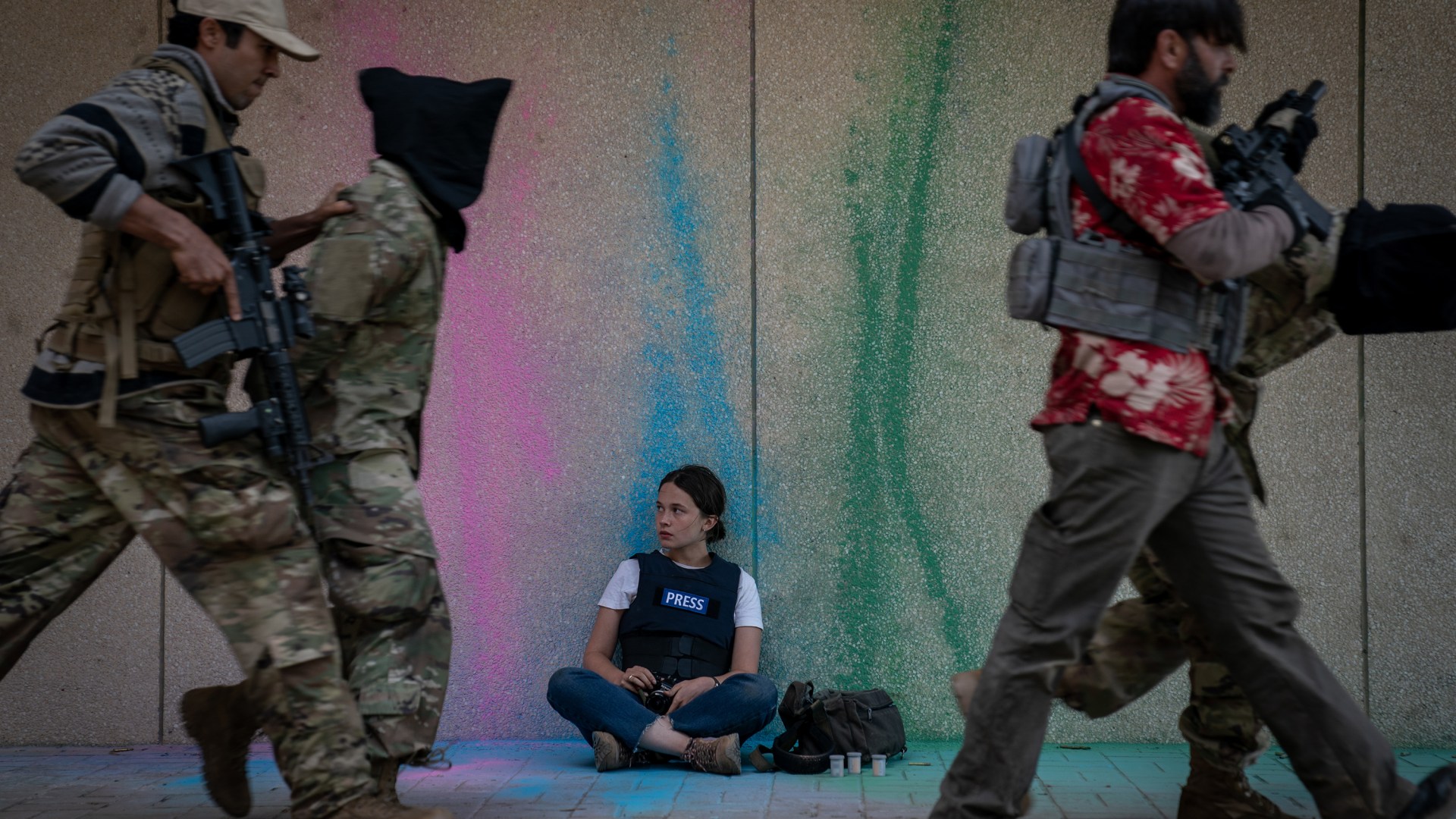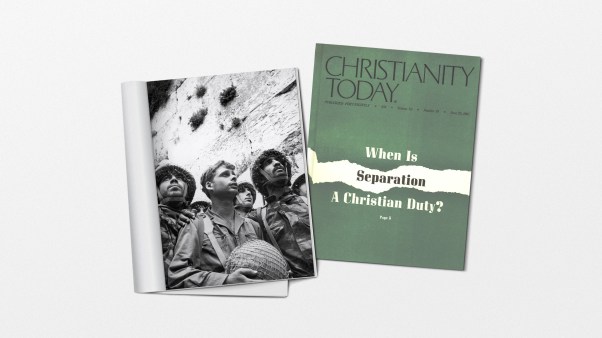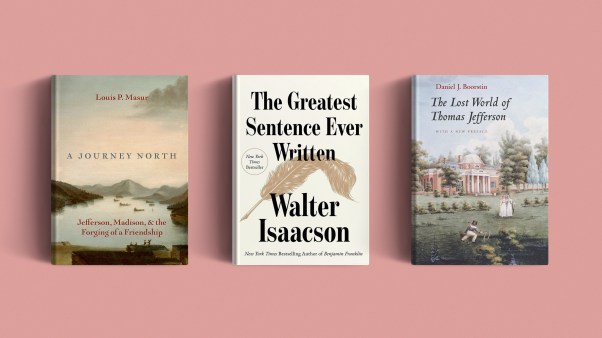There’s nothing more frightening than the sound of a camera shutter in the new film Civil War.
Distributed by A24, the production company behind releases like Everything Everywhere All at Once and Past Lives, the movie depicts the remnants of a United States government battling the Western Forces, an alliance between Texas and California. If you’re looking for reasons—Why these factions? Why now?—you won’t find any answers. The film is frustratingly opaque on logistics, though we’re able to hypothesize based on a few offhand comments. (The unnamed president, played by Nick Offerman, is entering his third term and isn’t gun-shy about using air strikes against American citizens.) Even so, a California that cooperates with Texas seems far-fetched.
For writer/director Alex Garland, our incredulity is the point. “I find it interesting that people would say, ‘These two states could never be together under any circumstances.’ Under any circumstances? Any? Are you sure?” he told The Atlantic. By asking us to accept his premise, Garland forces viewers to consider the ideological divisions we take for granted. Turns out, the why doesn’t matter all that much. Dystopia, no matter how it comes about, is still dystopia.
What is clear, though, is that the war provides an opportunity for journalists, capitalized on by photojournalist Lee (Kirsten Dunst), her Reuters colleague Joel (Wagner Moura), and her mentor, New York Times reporter Sammy (Stephen McKinley Henderson). Their coverage of atrocities shapes our experience of this imagined future. Many of those chilling camera shutter sounds come from Lee, as she documents truly terrible scenes of domestic conflict with ruthless efficiency and pristine technique. It’s jarring to see pictures of military soldiers being executed or a civilian being set on fire with perfect ISO and aperture.
Ever in pursuit of a scoop, the three decide to embark on a road trip from New York to DC, where Lee hopes to photograph the president and Joel hopes to interview him. “We get there before anyone else does,” Lee says. Joel agrees: “Interviewing him is the only story left.” At the last minute, they’re joined by Jessie (Cailee Spaeny), a young photojournalist who idolizes Lee. Together they embark on a tour of the crumbling nation.
With every click, the photographers get more disconnected from the war they’re documenting. Cinematographer Rob Hardy and editor Jake Roberts use recurring shots of each photo’s aftermath to terrifying effect. When the camera falls from Lee’s or Jessie’s face, it’s like a mask coming off.
Whether she’s captured a candid of an abandoned mall or a soldier who’s bled out, Lee’s dispassionate poise is chilling. She’s seen one too many atrocities, and whether for self-preservation or by overexposure, she’s desensitized to the horrors around her.
Young Jessie, however, is different. Whenever she’s done taking a photo, at least at first, audiences see the toll the work takes on her. It’s a tragedy when her empathy gives way to detachment. Each time her camera clicks, her face is less frightened, more stoic.
Civil War is an ode to the harrowing work of war journalists. But the film also pushes back against the notion that the highest virtue a journalist can cultivate is the ability to remain unfazed. While objectivity is imperative, it should be no badge of honor when we’re able to cover the worst of the world and not be moved.
In one painful sequence, after the crew witnesses a wanton act of violence, Lee tells a visibly shaken Jessie, “We record so other people ask.” Lee’s investment in a story ends after the click; she leaves it up to her audience to explore bigger questions about pain and purpose. “You want to be a journalist? That’s the job,” she scolds. One can’t deny the journalists’ commitment to capturing the truth of what they see. But it’s nonetheless disturbing when they do so without emotion.
The psalms of David take the opposite approach to the one modeled in Civil War—all lament, rejoicing, and rage as they interpret the world around them.
In David in Distress: His Portrait Through the Historical Psalms, scholar Vivian L. Johnson identifies certain songs that directly correlate with what’s covered in texts like 1 and 2 Samuel. One of these is Psalm 51, written in the aftermath of David’s rape of Bethsheba and his murder of her husband, Uriah, as recorded in 2 Samuel 11.
Whereas the history in Samuel provides the objective account of what’s happened, the psalm offers an opportunity to flesh out David’s inner, emotional experience. As Johnson writes, “Seldom do the Samuel narratives reveal the private contemplation of David or report his gestures of contrition; in fact, the books of Samuel in general show little reservation in their disclosure of his most egregious deeds.” Psalm 51, she argues, where David details his remorse more fully than in 2 Samuel’s one-line confession “I have sinned against the Lord,” “provid[es] for the reader an elaborate and pious version of what David may have said subsequent to recognizing the gravity of his actions when he murdered the husband of his mistress.”
The role of the psalmist is different from the role of the journalist. But what we see in Civil War reminds us, as does Scripture, of how vulnerable we can be in the face of the world’s hardships. For every record of an atrocity is a journalist who wrestles with bearing witness.
Take, for instance, a Rolling Stone gallery of images from photojournalists in Gaza. The photos are difficult to sift through and only more poignant now that the death toll there has exceeded 33,000 people. The presentation of these photos isn’t careless or salacious; instead, each is accompanied by a contextualizing caption. Photojournalist Ahmed Zakot describes Gaza on October 9, 2023: “I took this picture from the 19th floor of a skyscraper in Gaza. In my 25-year career as a photographer, I never felt such fear and distress. I felt that I was filming a cinematic movie scene, I had to remind myself that it is all too real.”
I can be like Lee. When I see archival photos from history or even images of today’s faraway atrocities, I’m moved to protect myself by keeping it all at arm’s length. It’s no wonder—in our online, overexposed world, ghastly images and testimonies are just a timeline refresh away.
But while dissociation might be understandable, it’s not desirable. That’s true not only of pain but also of joy. There’s Job’s address to God: anger fully expressed rather than circumstances merely accepted. But there’s also the first chapter of Luke, which makes room for Mary’s song.
Whereas other gospels are quick to narrate the events of Jesus’ birth, Luke pauses for a look at Mary’s heart. Her spirit “rejoices in God my Savior”; she can trust in the promises foretold by the angel Gabriel since God has shown his faithfulness “just as he promised our ancestors.” Even as it records the facts, Scripture makes room for lament, celebration, and praise, not stoicism.
Civil War offers a similar reminder. It’s not just what we witness that matters but how. Even as we remind ourselves that “it is all too real,” we remember a loving God who’s present in that reality. May we care for our souls as we look closely at suffering. May we also allow our hearts to break.
Zachary Lee serves as the Managing Editor at The Center for Public Justice. He writes about media, faith, technology, and the environment.









